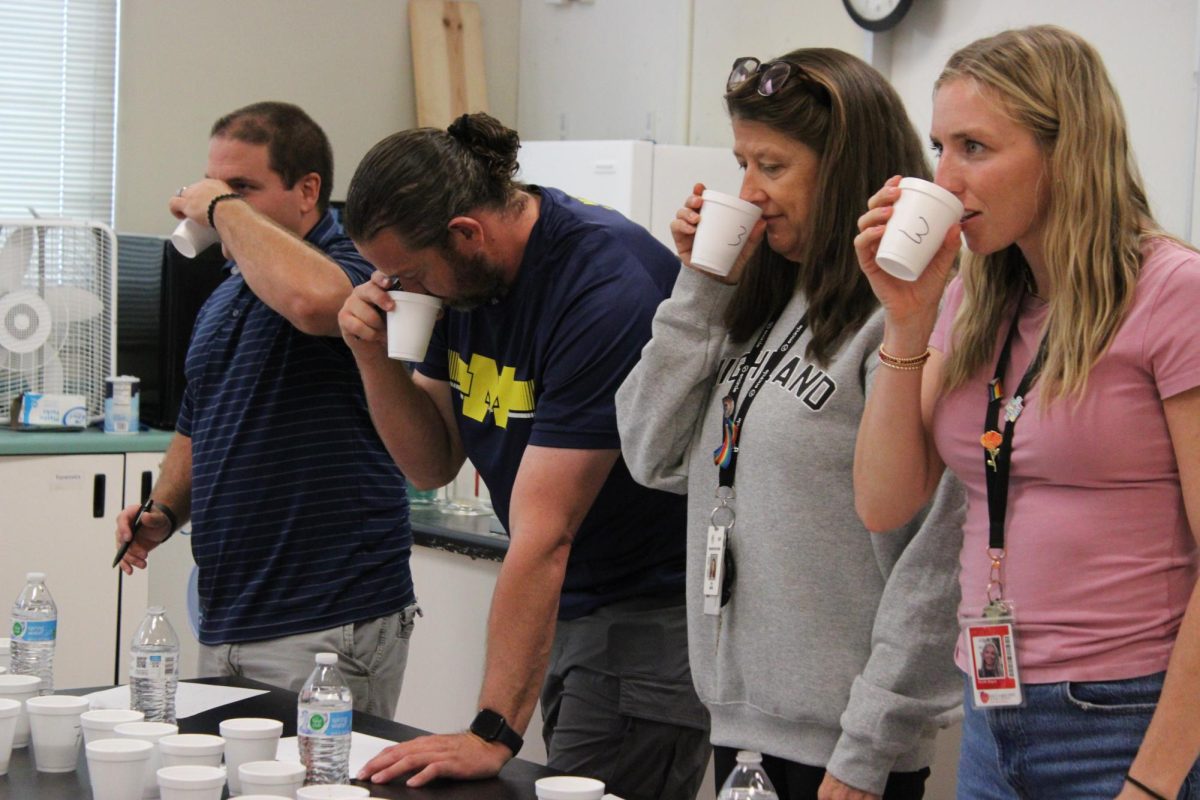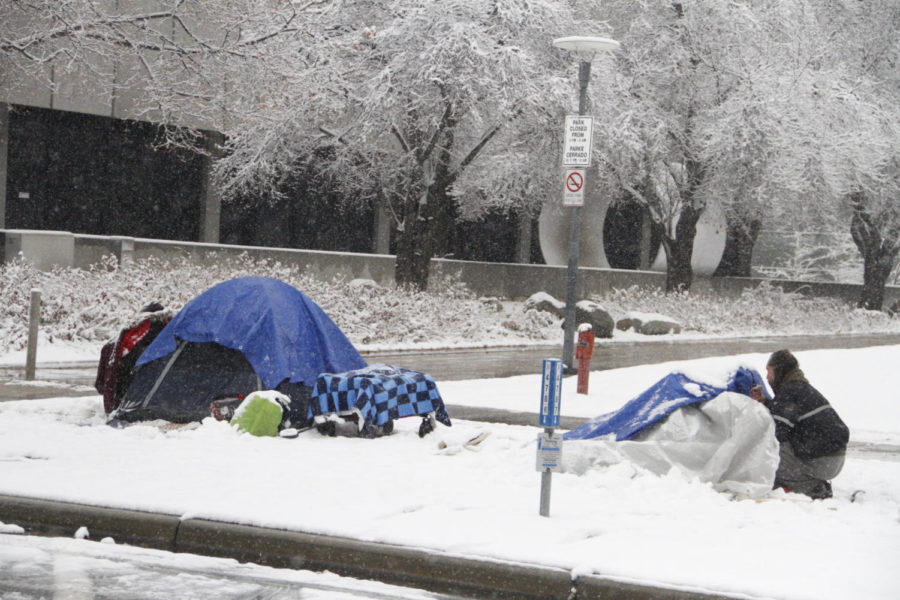Teen Homelessness Is A Serious Problem In The SLC School District
February 24, 2019
The bell rings signaling the end of class as students sling their bags onto their backs, having spent the past few moments hanging onto the straps of their backpacks in anticipation of the end of the school day. As the students shove past each other and weave around the slower-paced students to meet up with friends and hop into cars, no one takes too much notice of those around them.
Homelessness is an increasing crisis in many parts of the world, and is at large in Salt Lake City, Utah. It can be surprising to learn that a large portion of this homeless population is comprised of those considered to be youth. 15, 808 children under the age of six were identified homeless in 2013, and since then the number of homeless youth has only barely decreased. In 2015, 30% of estimated homeless youth were under age 18.
“For me, more than one (homeless child) is too many,” Mindi Rich said.
Rich is the advocate for McKinney Vento, a national organization that works with Highland helping students who fit the criteria of homeless.
Although the majority of the bustling students can’t wait to get home and spend a week-end away from school, a few students, more than you may think, don’t have a home to get back to. To them, the weekend offers no relief. What is typically a two-day streak of fun for many teens is a weekend without heat or food, creating an added level of stress and necessary survival for these less-fortunate students. These students spend their home-life either in a shelter, a foster home, or in the middle of a feuding family.
Perhaps one of the most common stereotypes of those who are homeless is the picture in someone’s mind of a dirty, trash filled stretch of sidewalk with people huddled against the walls desperately trying to cling to the warmth lingering on the bricks from the afternoon sun. While these people are homeless the categories go far beyond that. Homeless includes many different situations, not just lacking shelter. Homeless includes those in doubled housing, loss of housing, in shelters, trailer parks, hotels, unaccompanied youth, and youth not living with their designated legal guardian.
“When I was growing up my dad owned a motel and we saw a lot of people pass through there that were in precarious situations,” Rich said. “They were experiencing eviction, or they had lost a job, or experiencing substance abuse in the family, domestic violence. So I learned a lot about how precarious situations are especially when people lose their housing and how it just tumbles down and everything becomes hard.”
In the Salt Lake District East, West and Highland have a number of students in these homeless situations, East having the most and West and Highland lying about even. It is estimated that around 60 to 70 students a year at Highland are homeless, according to Rich. The main causes for a youth to become homeless are firstly, domestic violence and then affordable housing. Specific to Utah affordable housing is becoming a real issue as prices rise due to the lavish homes being built in the suburbs of Salt Lake City. Often times as a family’s rent increases, they cannot pay for the house in which they currently reside and are forced to move out or are evicted.
These students and youth often have limited options when it comes to a place to call home, or even just the simple luxury of having a roof over their heads and a floor under their feet. In some of the situations listed above, young adults can go live with relatives, or reside in a foster home, but a lot of the time these are simply not good options for youth. This leaves them homeless, an unfortunate and unimaginable situation to face at such a young age, many of these teens will turn to shelters.
Shelters are a great resource for people looking for somewhere to stay the night, they are however, extremely hard to get into. More often than not, a shelter has many more clients than it does bedding and food.
“The unfortunate reality there is that we are only able to shelter thirty clients every single night. That’s the maximum that we can allow, as far as our capacity for shelter. But our waiting list can get anywhere from 50 and I’ve seen it get up to 108 before,” Carlos Garcia, the youth services director at the VOA shelter, said. “So that means that once we’ve reached thirty everybody else that wasn’t within that thirty, they’re not able to be here for shelter.”
Mr. Garcia works downtown at a shelter organized specifically for homeless youth. Regular shelters are difficult to get a place in, but for youth they pose an increased number of challenges. Being in an adult shelter as a teen would be incredibly nerve wracking, something that no one should ever have to face. Many adults in a shelter are struggling with alcoholism or drug addiction, a large concern is that if a young adult were to be placed in that environment, they could potentially, and likely, pick up on these habits that will potentially shape their existence for the rest of their lives. That’s why non-profit organization shelters like the VOA (Volunteers of America) youth shelter have been put in place. The VOA is an international organization depending on volunteers from the communities it is based in. The shelter they have set up downtown is designed to cater to their clients and create a safe environment where they can not only feel comfortable, safe, and cared for, but where they can also receive an education and work towards building a career.
This unassuming building is what many young adults will call their home, at least for a time. From the outside the shelter looks just like any other building in the area, but inside is a modern facility designed to emulate safety and provide as much comfort as possible. After entering through the main door, immediately to the left is the front desk where clients can get on-hand hygiene products and speak with the front desk representative to do things like get on the waiting list or “check out” when they are leaving for a few hours. There is a large living area in this same room with a fireplace and a few places to sit, making the room as home-like as possible. Attached to this room is the kitchen where volunteers can come to cook meals for the shelter’s clients. This room does, however, lead a separate life at night, after 7:30 the homey room is converted into “shelter mode.” The furniture is cleared, and several pull out beds are laid out along with bed-sheets for the clients to sleep on during the night. The locker room is attached by a divider and this is where the female clients sleep. Through a door at the right corner of the locker room is the laundry facility for the staff to clean bed sheets and the room where the shelter takes donations such as clothes, shoes and hygiene products. The clients have their own small laundry center where they can wash their clothes. A corresponding hallway leads to bathrooms and showers.
The second floor is primarily focused on education and legal assistance. There are a few classrooms and a small library along with offices for staff and volunteers. This is also where clients can visit with a counselor or get legal assistance.
An unexpected asset of the shelter is the coffee shop next door. The shelter and its workers strive to ready their clients for adulthood and living on their own, this obviously entails the need for work experience, that is where this small business plays a role. The coffee shop, Maud’s Café, provides a job for the youth living at the shelter. The job teaches them basic barista skills so that they can then eventually get a full-time job working for another business, or just add it to a resume in their quest for another position.
Despite any unauthorized beliefs, these kids are dedicated to working hard and improving and securing a better future with which they can excel in with confidence.
The shelter takes in twenty day clients for an uncertain amount of time. After a client is accepted, they make a certain goal that is known to those who work at the shelter and are required to reach this goal within a week. The goals can be anywhere from staying at the shelter overnight to being hired for a work position to attending class at the shelter or a school. If these goals are met, they then make a new goal for the next week and are allowed to stay at the shelter as long as they continue to reach or strive towards these goals. If no efforts are being made, then their position is given to someone on the waiting list who has not been able to become a day client.
The shelter does provide some education, largely focusing on what their clients need most urgently concerning, finance, legality, and sexual education through their partnership with Planned Parenthood. The shelter is also a place where people can go to receive hygiene products, take a shower, speak with a clinician and do laundry. The people who work at the VOA shelter are trying to ensure a secure and stable future for their clients who need a little help to get there.
Befitting the name, Volunteers of America, this organization relies on the donation of time from members within the community. People who are interested in lending a hand can sign up to volunteer, this can be cooking dinner, bringing lightly used close that are no longer in use and donating hygiene products.
The shelter and its members along with Ms. Rich are dedicated to this work and making sure that all young adults have the opportunity to be their best selves and accomplish their greatest goals.





























